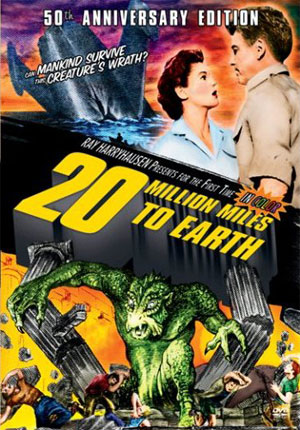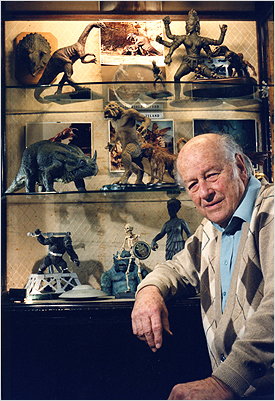 With our current CHUD design celebrating Clash of the Titans, now is as good a time as any to bring you this short one on one I did with Ray Harryhausen at San Diego Comic Con. Harryhausen was there to support the DVD release of a colorized version of his classic 20 Million Miles to Earth, the kind of big monster movie that JJ Abrams only dreams about.
With our current CHUD design celebrating Clash of the Titans, now is as good a time as any to bring you this short one on one I did with Ray Harryhausen at San Diego Comic Con. Harryhausen was there to support the DVD release of a colorized version of his classic 20 Million Miles to Earth, the kind of big monster movie that JJ Abrams only dreams about.
Harryhausen is an old man now, and the fingers that one manipulated sword swinging skeletons and the Ymir don’t have the same mobility, but he still has a spark in his eyes and his voice. Maybe playing with monsters his whole life kept him young and vital – now that’s an age defying plan I can get behind. Sitting down with Harryhausen was one of those amazing, surreal moments that I never even imagined as a kid when thrilling to The Seventh Voyage of Sinbad or Jason and the Argonauts or dragging my mother to see Clash of the Titans again and again in theaters. I’m always going to be the kind of person who prefers the subtly herky-jerky movement of Harryhausen’s stop motion figures over the smoothest and most amazing CGI characters. WETA and ILM do science. Ray Harryhausen made magic.
You can order the colorized version of 20 Million Miles to Earth from CHUD by clicking right here, or you can find it right now in stores near you.
Ted Turner started colorizing years ago, but it never stuck. Why go back to it now?
The process wasn’t as refined as it is today. Over the years it developed into a very impressive process. We would have shot all of our pictures in color, but we didn’t have the budget. I think the new colorization process, particularly that Legend has, will give these [films] a new life. We colorized She, an old black and white film Merian Cooper made in 1935, and it makes a spectacle out of it. There is a plus value to this new colorization. If you see She, if you see 20 Million Miles to Earth now, you’ll think it was shot in color, because it looks good.
When you were shooting 20 Million Miles and you knew you were shooting for black and white, were the models you were animating true color or…?
I colorized the creature from Venus in green but it would come out grey in the black and white film. Now it’s the proper color it should have been for a creature from outer space.
How long does the process take?
It takes a long [time]. It’s very complicated. I don’t know all the details myself, because I just look at film and suggest colors that certain scenes require. I work very closely with Rosemary Horvath of Legend Films, a very creative person. She knows what button to push to get the color!
Are you going to be revisiting more of your older films for colorization?
Earth vs The Flying Saucer and 20 Million Miles have just been colorized. We hope to colorize The Beast From 20,000 Fathoms. All our early black and white films.
Do you think that the kids who today are raised on CGI are going to take to the stop motion process?
I get a lot of fan mail that says they prefer our films to CGI because they have more heart. There’s a process that goes on with stop motion where if you try to make fantasy too real you lose the whole point of making a fantasy. It becomes a comic strip instead of a fantasy.
That’s what you’re really famous for – your creatures have a humanity to them.
We try to get sympathy for our creatures. For example, in 20 Million Miles to Earth, this creature was brought down against its will to a new civilization and the air made it grow big  over night. It wasn’t belligerent until a farmer jabbed it with a pitchfork, and then it became belligerent. We tried to stress that in the early stages. We had a tagline on the picture: ‘Why does it take such a toll to go from the present into the future.’
over night. It wasn’t belligerent until a farmer jabbed it with a pitchfork, and then it became belligerent. We tried to stress that in the early stages. We had a tagline on the picture: ‘Why does it take such a toll to go from the present into the future.’
I worked with the scriptwriter right from the beginning. I wear many different hats. People seem to associate me with only being a technician; many times I bring the story in. I brought 20 Million Miles to Earth, but I never took credit. I was very modest in those days, and it took me years to learn that modesty is a dirty word!
Is there a particular creature that you find yourself looking back on the most fondly?
I can’t. The others get jealous.
Is there one that you look back and say, ‘Boy I wish I had more time to work on that one.’
Every time I see it, I wish I had taken fifteen or twenty minutes more on [one] scene [or another], but you can’t change it in the can. It seemed suitable at the time. But there are many times I’d like to correct certain things, because 9/10ths of everything you see is a first take. We didn’t have time to refine like you can today with CGI. With a film process every time you duped it, it looked dupey. It looked more dupey and dupey and dupey. You had to be careful you didn’t dupe it too many times.
Before you mentioned the idea that stop motion has more heart than CGI. Is there something else, though – a weight, a texture, a feeling?
There’s a strange process that goes on in stop motion that is ideal for fantasy. If you try to make fantasy too real, I think you’re ruining fantasy. Fantasy comes from the imagination. It comes from the dream world. It’s not supposed to be extremely real. That was what fascinated me when I first saw King Kong – I knew it wasn’t a man in a suit and I just felt it had a dimension I remembered and that got me into my career.
Have you seen the new King Kong?
I’ve seen it, yes.
It’s not the same.
It’s another point of view. When I saw the first King Kong, everything was condensed into an hour and a half because anybody that goes to see a film called King Kong is not that interested in Anne Darrow’s past. They’re interested in the gorilla!